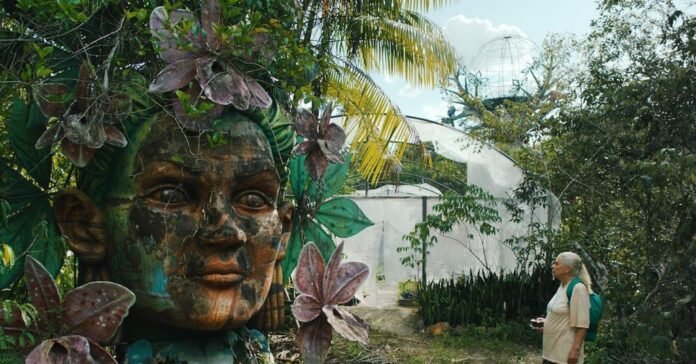Dir. Gabriel Mascaro. Brazil/Mexico/Netherlands/Chile 2025. 86mins.
Gabriel Mascaro’s The Blue Path is a balmy riverboat journey into the unknown – in addition to a bolshy protest in opposition to ageism and a warning about doable authoritarian futures, in Brazil and elsewhere. Brazilian filmmaker Mascaro captured consideration with working-class drama Neon Bull (2015), however his new movie is a considerably gentler follow-up to 2019’s Divine Love, which was a stylised imaginative and prescient of a fundamentalist dystopia.
A really believable imaginative and prescient of a darkish and hypocritical future
Centred on a successful efficiency from Brazilian stage and display screen veteran Denise Weinberg, with help together with worldwide star Rodrigo Santoro (300, Westworld et al), The Blue Path is entrancingly unpredictable in its picaresque unravelling, tinged with magical realist touches. Following its bow in Berlinale Competitors, the movie is more likely to tow happy worldwide audiences in its wake.
Weinberg performs Tereza, a 77-year-old lady who works in a manufacturing facility that processes alligator meat. She’s blissful and assured dwelling alone, however she is a citizen of a future Brazil wherein older individuals have a wierd standing. They’re celebrated with laurels positioned on their houses, and instructed that they’re honoured members in a thriving society, with planes flying overhead broadcasting messages of their honour. Tereza is even knowledgeable she is now formally a “nationwide dwelling heritage.”
However we quickly uncover the flip aspect of this veneration: older individuals are compelled to retire and are positioned below the official guardianship of their kids, unable to make the best purchases with out producing ID and having transactions cleared by their household. And in the event that they transgress, they’re rounded up and transported in what the subtitles name ‘Wrinkle Wagons’ – basically senior-citizen dog-catcher vans. What additionally awaits them is switch to the ‘Colony’ – supposedly a much-desired relaxation house, however fairly clearly a dumping floor for individuals not seen as a helpful a part of the workforce.
Earlier than being packed off, Tereza decides to fulfil her dearest want: to take a aircraft journey. However that can contain securing an unlawful flight from a backwater on the Amazon – so she hitches a journey with taciturn riverboat skipper Cadu (Santoro). En route, they’re compelled to cease – which is when Cadu introduces Tereza to the mysterious ‘blue drool snail’, whose slime, used as eye drops, permits the consumer to see their future. Tereza’s journey then suffers a significant hiccup, however her tenacity wins out and she or he is quickly again on the water with Roberta (Miriam Socarras), a rakish free spirit of Tereza’s age. Often known as the Nun, Roberta makes a dwelling promoting digital bibles however believes solely in freedom – which she has managed to safe at a worth.
With its narrative roots in a darkish imaginative and prescient of institutionalised ageism – not dissimilar from the situation of twice-filmed Japanese drama The Ballad of Narayama – The Blue Path efficiently avoids the traps of winsome impishness that so typically have an effect on tales about fights for late-life independence, which may simply play out as condescending regardless of finest intentions. Right here, Weinberg decisively establishes Tereza’s no-bullshit perspective from the beginning, and she or he and the brash, characterful Socarras make an impressive crew as soon as they meet up within the latter a part of the journey. Santoro additionally makes a powerful impression because the powerful loner who proves very susceptible, confessing his woes to Tereza in a hallucinated trance (the actor’s candid eyes right here tinged a bizarre blue).
Mascaro and manufacturing designer Dayse Barreto create a really believable imaginative and prescient of a darkish and hypocritical future – a world much less visibly hi-tech than Divine Love, the foundations right here primarily established via adverts and glimpses of mendacious propaganda movies (plus the odd piece of graffiti, like ‘Give Me Again My Granddad’). The uncommon moments the place the movie jumps right into a magical-realist mode – not within the least jarringly – are within the snail sequences and in Tereza’s go to to a really singular playing den.
All through, the movie follows its personal twisting route, by water or in any other case, with DoP Guillermo Garza capturing some magnificent river vistas. Memo Guerra’s rating is slathered on a bit thickly, often overplayed as a comic book commentary, however total its unconventional jazzy textures and rhythms properly match the tone of a movie that just about has its eccentricity calibrated completely.
Manufacturing firms: Desvia Filmes, Cinevinay
Worldwide gross sales: Fortunate Quantity, olivier@luckynumber.fr
Producers: Rachel Daisy Ellis, Sandino Saravia Vinay
Screenplay: Gabriel Mascaro, Tibério Azul
Cinematography: Guillermo Garza
Manufacturing design: Dayse Barreto
Editors: Sebastián Sepúlveda, Omar Guzmán
Music: Memo Guerra
Foremost forged: Denise Weinberg, Rodrigo Santoro, Miriam Socarrás, Adanilo
